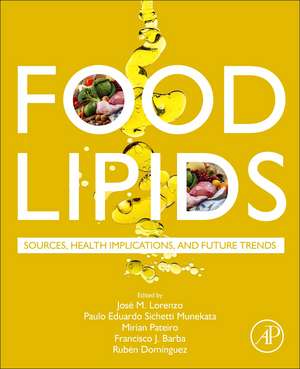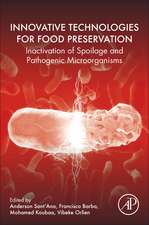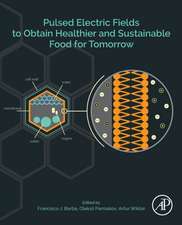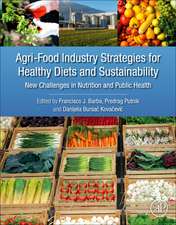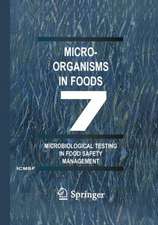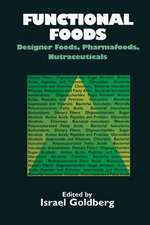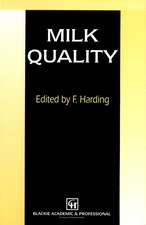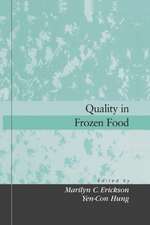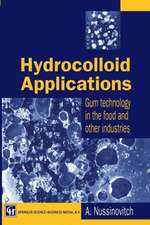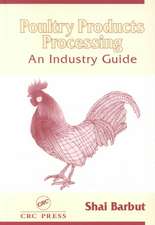Food Lipids: Sources, Health Implications, and Future Trends
Editat de Jose M. Lorenzo, Paulo Eduardo Sichetti Munekata, Mirian Pateiro, Francisco J. Barba, Rubén Domínguezen Limba Engleză Paperback – 6 mar 2022
Lipids are vital for human nutrition as they provide energy to the biological processes of the body and contain substances with high importance as essential fatty acids or fat-soluble vitamins. Furthermore, lipids are responsible for many desirable characteristics of foods. However, in recent years consumers are increasingly aware of the diet-health relationship, especially the implication that some lipids exert in the development of different diseases.
- Provides clear information on obtaining, characterizing and applying lipids in several food products
- Offers strategies to apply new emerging technologies to the recovery of valuable lipids from food by-products, the use of innovative techniques of encapsulation to protect highly oxidizable lipids, and the use of this lipids to produce healthier foods
- Includes definitions, applications, literature reviews, recent developments, methods and end-of-chapter glossaries
Preț: 906.48 lei
Preț vechi: 1183.97 lei
-23% Nou
Puncte Express: 1360
Preț estimativ în valută:
173.45€ • 180.75$ • 143.62£
173.45€ • 180.75$ • 143.62£
Carte tipărită la comandă
Livrare economică 27 martie-10 aprilie
Preluare comenzi: 021 569.72.76
Specificații
ISBN-13: 9780128233719
ISBN-10: 0128233710
Pagini: 516
Dimensiuni: 191 x 235 mm
Greutate: 0.88 kg
Editura: ELSEVIER SCIENCE
ISBN-10: 0128233710
Pagini: 516
Dimensiuni: 191 x 235 mm
Greutate: 0.88 kg
Editura: ELSEVIER SCIENCE
Cuprins
1. Introduction and Classification of Lipids
Part 1: Lipid Sources and Their Chemical Composition
2. Animal source. Meat, subcutaneous fat, milk and dairy products
3. Marine source. Fish, shellfish and algae
4. Plant source. Vegetable oils
Part 2: Oxidative Degradation
5. Lipid oxidation of animal fat
6. Lipid oxidation of marine oils
7. Lipid oxidation of vegetable oils
Part 3: Lipid Analysis in Food
8. Fat and fatty acids
9. Cholesterol and cholesterol oxidation products (COPs)
10. Fat-soluble vitamins (A, E, D, and K)
11. Lipid-derived oxidation products
Part 4: Lipids in Human Health
12. Fatty acids
13. Importance of n-3 long chain and CLA
14. Sterols and fat-soluble vitamins
15. Dietary oxidized lipids
Part 5: Future Trend
16. Application of emerging technologies to obtain valuable lipids from food by-products
17. Encapsulation techniques to increase lipid stability
18. Replacement of saturated fat by healthy oils to improve nutritional quality of foods
Part 1: Lipid Sources and Their Chemical Composition
2. Animal source. Meat, subcutaneous fat, milk and dairy products
3. Marine source. Fish, shellfish and algae
4. Plant source. Vegetable oils
Part 2: Oxidative Degradation
5. Lipid oxidation of animal fat
6. Lipid oxidation of marine oils
7. Lipid oxidation of vegetable oils
Part 3: Lipid Analysis in Food
8. Fat and fatty acids
9. Cholesterol and cholesterol oxidation products (COPs)
10. Fat-soluble vitamins (A, E, D, and K)
11. Lipid-derived oxidation products
Part 4: Lipids in Human Health
12. Fatty acids
13. Importance of n-3 long chain and CLA
14. Sterols and fat-soluble vitamins
15. Dietary oxidized lipids
Part 5: Future Trend
16. Application of emerging technologies to obtain valuable lipids from food by-products
17. Encapsulation techniques to increase lipid stability
18. Replacement of saturated fat by healthy oils to improve nutritional quality of foods
